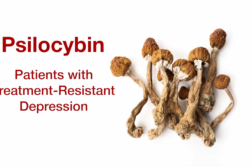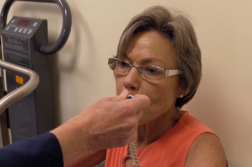ORLANDO, Fla. (Ivanhoe Newswire) — Breast cancer impacts one in every eight American women. Researchers are constantly searching for new ways to diagnose and treat this all-too-common disease. Ivanhoe reports on some of the most recent breakthroughs in breast cancer care.
Kristen Lyons was only 39 when she noticed a suspicious lump in her breast.
“I just, I felt something and I thought, huh, it was real tiny, but it just felt different,” explained Lyons.
It was breast cancer.
“It was about Tic Tac sized. It was very tiny, very treatable and hadn’t spread into the lymph nodes or anything like that,” continued Lyons.
Researchers are working hard to ensure that other women have a positive outcome like Lyons. One of the latest breakthroughs is a drug called Trodelvy. It was approved for patients with metastatic triple-negative breast cancer, a type of breast cancer that’s usually very hard to treat. Several new treatments for HER2-positive breast cancer that have also gained approval in the last two years are: Enhertu, Nerlynx, Tukysa, and Phesgo. Liquid biopsy is another recent breakthrough that’s made a difference in breast cancer care. It’s essentially a blood test that detects the presence of cancer. In a study from Memorial Sloan Kettering in New York, researchers used the test in women with estrogen receptor-positive metastatic breast cancer to successfully identify gene mutations and tailor treatments. Breakthroughs that could help more women beat breast cancer.
An artificial intelligence algorithm is also helping doctors identify breast cancer on mammograms. In a study from Sweden, the AI technique was better at detecting breast cancer than six radiologists. Pairing a radiologist with AI produced even better results.
Contributors to this news report include: Julie Marks, Producer; and Roque Correa, Editor.
BREAKTHROUGHS IN BREAST CANCER
REPORT #2901
BACKGROUND: Breast cancer is a term that refers to a malignant tumor that has developed from cells in the breast that either begin in the lobules, milk-producing glands, or ducts, the passages that drain milk from the lobules to the nipple. Less commonly, breast cancer can begin in the stromal tissues, which include the fatty and fibrous connective tissues of the breast. Over time, cancer cells can invade nearby healthy breast tissue and make their way into the underarm lymph nodes, or the small organs that filter out foreign substances in the body. Breast cancer is always caused by a genetic abnormality (a “mistake” in the genetic material). However, only 5-10% of cancers are due to an abnormality inherited from your mother or father, and 85-90% of breast cancers are due to genetic abnormalities that happen as a result of the aging process and life in general.
(Source: https://www.breastcancer.org/symptoms/understand_bc/what_is_bc)
SIGNS AND SYMPTOMS: The body will produce certain warning signs with breast cancer. The most common is a lump in the breast, which may be located anywhere along the chest wall to under the armpit. There may be nipple bleeding or discharge, as well as related pain. There may be redness and/or swelling in any area of the breast or in one breast and not the other, and the nipple could look flatter or caved in. Early signs of breast cancer are discovered on imaging tests. When the tumor is small in the early stages, it’s rarely noticeable to the touch or the naked eye. That’s why mammograms play an important role. Mammograms (low-dose X-rays of the breast) can help detect a tumor in the breast long before it’s big enough to start causing symptoms and when the cancer is likely to be more easily treatable. According to the American Cancer Society, regular mammograms are the most reliable way to catch breast cancer early.
(Source: https://www.cancercenter.com/cancer-types/breast-cancer/symptoms)
ARTIFICIAL INTELLIGENCE AND MAMMOGRAMS: According to a study co-authored by UMass Medical School breast imaging expert Gopal Vijayaraghavan, MD, MPH, an artificial intelligence model for computer-aided reading of mammograms may improve the detection of breast cancer. The AI model uses a complex pattern recognition algorithm to detect and classify areas of concern. The analysis was conducted on screening mammograms, known as index exams, which identified cancer in 131 patients. Of these patients, 120 had a prior mammogram within the past two years in which cancer was not identified, known as pre-index exams. The deep-learning algorithm performed higher than the expert readers in the diagnosis of both the index cases and the pre-index examinations, with a 17.5% increase in sensitivity and 16.2% increase in specificity. “Our results provide evidence that AI can aid in earlier breast cancer detection. Importantly, the AI algorithms we evaluated were not previously trained on data from sites used in the study, demonstrating an ability to generalize to new clinics,” said Bill Lotter, PhD, chief technology officer and co-founder of DeepHealth. “Such generalization is a common challenge in AI that is essential for real-world utility.”
* For More Information, Contact:
Dan Collins, Mercy Medical Center
Free weekly e-mail on Medical Breakthroughs from Ivanhoe. To sign up: http://www.ivanhoe.com/ftk



